CT and MRI help evaluate adrenal gland disorders
The adrenal glands are paired retroperitoneal endocrine organs. They are thin, inverted Y- or V-shaped soft tissue structures and have flat or concave margins. The vertical length of each gland may be anywhere from 2 to 4 cm. Their “limbs” are approximately 0.4 cm thick in axial cross-section, which is roughly as thin as the adjacent diaphragmatic crus.
The adrenal glands are paired retroperitoneal endocrine organs. They are thin, inverted Y- or V-shaped soft tissue structures and have flat or concave margins.1 The vertical length of each gland may be anywhere from 2 to 4 cm. Their “limbs” are approximately 0.4 cm thick in axial cross-section, which is roughly as thin as the adjacent diaphragmatic crus.2
CT is the primary imaging method for evaluating adrenal disorders. To detect small lesions and correct CT attenuation measurement requires thin-section scanning (3 mm or less) through the adrenal fossa using a small field-of-view.3 Intravenous contrast can be useful when characterizing the enhancement pattern of lesions on portal venous phase images or evaluating washout on delayed-enhancement images.4 Reformatted images in the sagittal and coronal planes can sometimes help to determine the exact origin of lesions.
MRI is most useful as an alternative to CT in patients who cannot tolerate intravenous iodinated contrast and/or when confirming a diagnosis of hemorrhage. The study protocol should include T1-weighted gradient echo sequences in and out of phase in the axial and coronal planes and T2-weighted echo-train spin-echo sequences in the axial and coronal planes. T2-weighted sequences in the axial plane should also be obtained after fat saturation.
LESION EVALUATION
A variety of lesions may be seen in the adrenal glands.
Adenomas are the most common adrenal lesions.2,4 Adrenal adenomas are round or oval homogeneous masses with well-defined margins and are usually smaller than 3 cm. Most (80% to 85%) contain substantial amounts of intracytoplasmic lipid.5 This finding is important when making a specific diagnosis of adenoma on CT and/or MRI.6
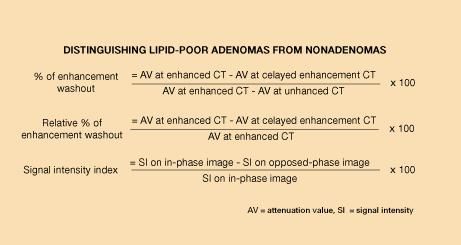
Lipid-rich adenomas can be characterized on unenhanced CT by attenuation values between -10 Hounsfield units and 10 HU.1,4,7 All adenomas tend to show rapid loss of attenuation values soon after enhancement when imaging with intravenous contrast. Lipid-poor adenomas can be differentiated from lesions that are not adenomas by calculating the percentage of enhancement washout 15 minutes after contrast administration (Figure 1). A diagnosis of adenoma can be made when the absolute percentage of enhancement washout is more than 60% or when the relative percentage of enhancement washout is more than 40%.4
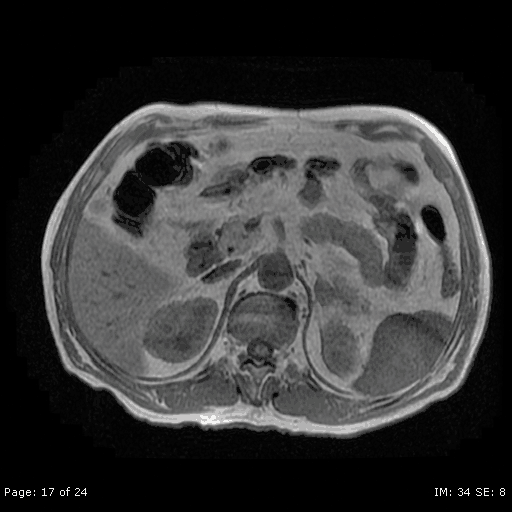
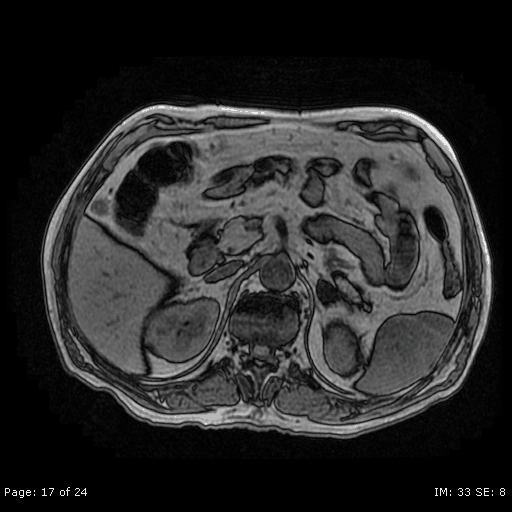
Adenomas characteristically reveal homogeneous signal intensity on all MRI pulse sequences, with relative isointensity to liver on T2-weighted images. The amount of intracellular lipid corresponds to the amount of signal intensity lost on chemical-shift MRI (Figure 2). A diagnosis of adenoma can be made if the signal intensity index is above 20% (Figure 1).2Myelolipoma is an uncommon benign tumor composed of fat and hematopoietic tissue in varying proportions.3,8 The presence of macroscopic fat is critical to the diagnosis because virtually no other adrenal lesion contains fat.6
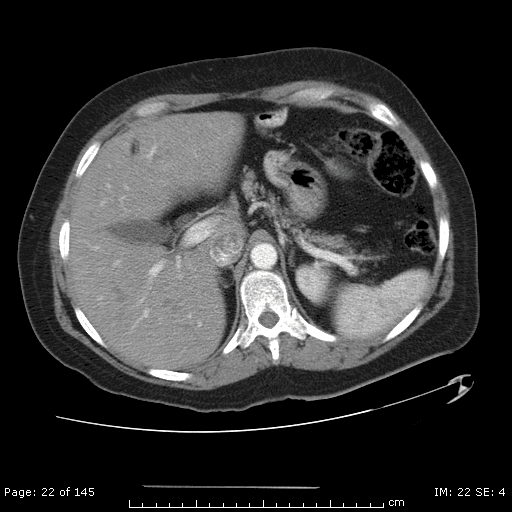
The presence of near-fat attenuation values on CT (less than -20 HU) is typical of adrenal myelolipoma (Figure 3).1 MRI with fat suppression will confirm the diagnosis, demonstrating a loss of signal intensity within the fatty component.2,6Adrenal cystic lesions are rare. They can be classified into four major histopathological subtypes: endothelial cysts (45%), pseudocysts (39%), epithelial cysts (9%), and parasitic cysts (7%).3,6 The imaging features of the different subtypes overlap significantly. Simple cysts are seen on CT as nonenhancing, low-density round or oval lesions (<10 HU) with smooth borders and thin walls (<3 mm).1 Curvilinear or punctate calcifications are more common in pseudocysts. Cysts are homogeneous and hypointense on T1-weighted MRI and hyperintense on T2-weighted MRI. Concern about malignancy is reasonable in the presence of intralesional enhancement, irregular thick walls, and septations. Adrenal hematomas can be caused by spontaneous hemorrhage or bleeding induced by trauma. Imaging features vary according to the age of the hematoma.2 Acute to subacute adrenal hematomas have increased attenuation on CT (50 to 90 HU).1 Follow-up imaging should show attenuation dropping and the lesions gradually diminishing in size.3,9 Calcifications may develop a few months after adrenal hemorrhage. Acute hemorrhage (days one to six) will be rich in deoxyhemoglobin, which is isointense relative to muscle on T1-weighted MRI and has low signal intensity on T2-weighted MRI. Methemoglobin, present in the subacute phase (one to five weeks after onset), causes high signal intensity on T1-weighted images and variable signal intensity on T2-weighted images. Chronic hemorrhage (after five weeks) shows the gradual formation of hemosiderin as areas of low signal intensity on both T1- and T2-weighted MRI.
Adrenal calcifications can be found in a great variety of lesions, including adenoma and myelolipoma, for example. They may also be observed in many diseases, such as storage disorders. Some CT features may suggest a more specific diagnosis. Prior adrenal hemorrhage frequently leads to coarse and irregular calcifications.8 Calcifications associated with tumors are more usually mottled and scattered within a soft tissue mass. Granulomatous infections may leave small, faint, diffuse calcifications within a normal-sized or atrophic gland.8Adrenal carcinoma is extremely rare. It has a bimodal age distribution with an initial peak in the pediatric population (before six years old) and a second peak between the ages of 40 and 50. Patients with hyperfunctioning cancers (50%) frequently present with signs and symptoms of excess cortisol (Cushing’s syndrome) and androgen (virilization).2 Nonhypersecreting tumors are discovered incidentally or are found secondary to a localized mass effect or symptomatic metastatic disease.
Adrenal carcinoma presents on CT as a large mass (>5 cm) in 90% of cases, with irregular margins and heterogeneous attenuation (due to areas of necrosis and hemorrhage). The solid component shows marked contrast enhancement with slow washout. Calcifications are seen in 30% of cases.
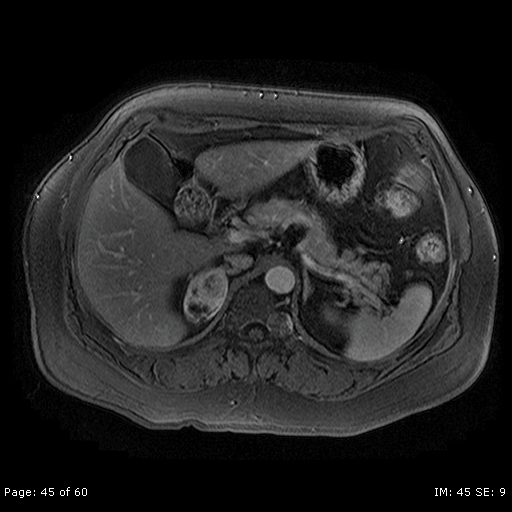
Adrenal carcinoma has heterogeneous low signal on T1-weighted MRI and heterogeneous high signal on T2-weighted images (Figure 4).3,8 Some masses may lose focal signal intensity in chemical shift imaging.2,6
Primary adrenal lymphoma is rare. Secondary involvement of adrenal glands by lymphoma is reported in 1% to 4% of cases, more commonly in non-Hodgkin’s disease.10 Patients with bilateral adrenal involvement may present with Addison’s disease.
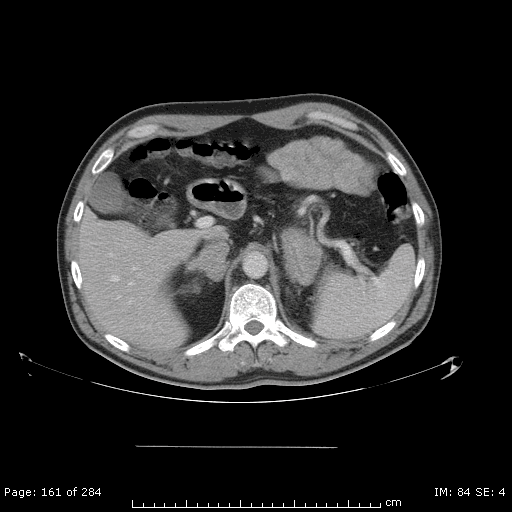
CT and MRI findings of adrenal lymphoma are nonspecific and definitive diagnosis must be established by histological evidence. CT shows soft tissue masses that enlarge or replace the gland (Figure 5).9 Contrast enhancement is similar to that seen with retroperitoneal adenopathies. Masses have low signal intensity on T1-weighted MRI and heterogeneous high signal intensity on T2-weighted MRI.2,6Adrenal metastases may be formed by primary tumors that spread. These commonly include lung, breast, and renal cell carcinomas, and melanoma. Adrenal metastases are highly variable in both size and appearance on imaging studies.
Small metastases are usually homogeneous on CT while the larger metastases tend to be heterogeneous and irregularly contoured. Enhancement is usually progressive after contrast administration, unlike adenoma enhancement, and persists for several minutes.
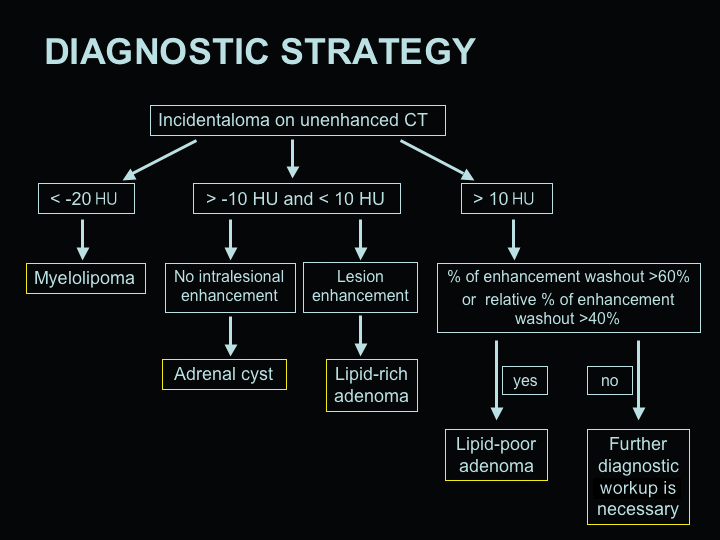
The appearance of metastatic disease in the adrenal glands is variable on MRI. The most common presentation is low signal intensity on T1-weighted imaging and high signal intensity on T2-weighted imaging. Metastatic lesions do not lose signal intensity on chemical shift imaging. A rare exception to this rule is metastases from clear cell renal carcinoma.2 Metastases cannot be ruled out from adrenal glands that appear grossly normal or hyperplastic.
As outlined above, certain imaging features can be helpful in the differential diagnosis of adrenal lesions. A systematic approach is recommended (Figure 6).
ENDOCRINE DISEASES
Systemic disease tends to affect the whole of the adrenal glands bilaterally.
Cushing’s syndrome is a multisystem disorder that results from chronic exposure to elevated concentrations of free-circulating glucocorticoids.11 Adrenocorticotropic hormone (ACTH)-dependent Cushing’s syndrome is caused by a pituitary corticotroph adenoma (80% to 85% of cases) or an ectopic ACTH-secreting tumor (15% to 20% of cases).12
ACTH hyperstimulation results in adrenal hyperplasia that is typically bilateral. It may be either diffuse (most common) or nodular. An apparently normal CT or MRI appearance of the adrenal glands, observed in 30% of cases, should not exclude suspicion of histopathological hyperplasia.11
Diffuse hyperplasia is characterized by diffuse, uniform thickening of the adrenal glands, which maintain a smooth contour.3,12 Nodularity is thought to follow long-standing adrenal stimulation.12 Nodules may be microscopic (micronodular) or visible (macronodular).3 One or more discrete nodules that are isointense to normal liver on T2-weighted MRI will be seen in macronodular hyperplasia. The internodular cortex is always hyperplasic in such cases.
ACTH-independent Cushing’s syndrome is caused by an autonomous primary adrenal pathology that produces cortisol. Adrenal adenomas and carcinomas account for 95% of cases.11 Bilateral disease, including primary pigmented nodular adrenal dysplasia (PPNAD) and ACTH-independent macronodular adrenal hyperplasia (AIMAH), is responsible for almost all of the remainder.
PPNAD is a rare cause of Cushing’s syndrome and typically affects young female patients. It may be familial (50%) and is frequently associated with the Carney complex (mixomas, spotty pigmentation, and endocrine overactivity). 11
Adrenal glands may be normal or minimally hyperplasic with multiple unilateral or bilateral benign cortical nodules on CT and MRI.1 These nodules do not normally exceed 0.5 cm, though in older patients they may be up to 1 or 2 cm. The nodules are hypointense on both T1- and T2-weighted imaging, and are macroscopically pigmented. The internodular cortex is atrophic.
AIMAH is another rare cause of Cushing’s syndrome, occurring more frequently in men in their 40s. It is characterized by massive bilateral adrenal enlargement together with the appearance of multiple macronodules up to 5 cm in diameter.11 Attenuation values for the nodules are low on unenhanced CT. T1-weighted MRI shows the nodules as being isointense relative to muscle, while on T2-weighted MRI they are hyperintense relative to normal liver. Signal intensity may be lost on opposed-phase chemical-shift imaging. The morphology of the internodular cortex is uncertain.
Conn’s syndrome, or primary aldosteronism, results from excessive adrenal production of aldosterona.3 The majority of cases (95%) are due to an autonomous cortical adenoma (aldosteronoma). Most of the remaining cases result from primary idiopathic bilateral hyperplasia.13 Adrenocortical carcinomas only rarely excrete aldosterone. Identification of the underlying cause has important therapeutic implications: adenomas are treated surgically while hyperplasia is managed with drug therapy.
The size of the aldosteronomas usually ranges from 0.5 to 3.5 cm. Primary adrenal hyperplasia may be micronodular or macronodular. In macronodular hyperplasia, the presence of a dominant nodule or of a concomitant nonhyperfunctioning adenoma may lead to a false-positive diagnosis of aldosteronoma.
A diagnostic algorithm based on the morphology of adrenal glands as seen on CT has been proposed as follows:14
- • Mean limb width <3 mm: aldosterone-producing adenoma. If there is no visible nodule, adrenal venous sampling is recommended to locate the adenoma.
- • Mean limb width >5 mm: bilateral adrenal hyperplasia.
- • Mean limb width 3 to 5 mm: inconclusive. Adrenal venous sampling is recommended to establish the diagnosis.
MRI offers no advantages over CT.
Addison’s disease, or primary adrenocortical insufficiency, results from the destruction of at least 90% of the adrenal cortex.3,10 The acute form is most frequently caused by bilateral adrenal hemorrhage. The subacute form (less than two years) is usually attributable to infectious-inflammatory and granulomatous processes. CT shows mild to moderate adrenal enlargement, usually bilateral and symmetrical.1
The chronic form of Addison’s disease (more than two years) is most often due to idiopathic adrenocortical atrophy (autoimmune process). This is seen on CT as bilateral adrenal atrophy without calcifications. Other common causes include previous granulomatous disease (small glands, partly or completely calcified), remote adrenal hemorrhage (very dense calcifications with no soft tissue), and hemochromatosis (normal or small glands with increased attenuation values).
Primary adrenogenital syndrome is a rare inherited disorder based on a congenital enzyme defect in steroid synthesis. This results in absent or deficient cortisol and/or aldosterone production. 3 ACTH stimulation by the pituitary gland is increased, leading to excessive androgen secretion. 1 Imaging studies show adrenal hyperplasia. Enlargement is bilateral, coarse, and tumorous, though the glands retain their normal shape.
Pheochromocytoma is a neuroendocrine tumor of chromaffin cell origin arising from the adrenal medulla. The diagnosis is established biochemically by the detection of elevated levels of catecholamines and their metabolites in blood plasma and urine.6,8 It has been called the “10% tumor” because approximately 10% are bilateral, 10% are extra-adrenal, 10% occur in children, and 10% are malignant.
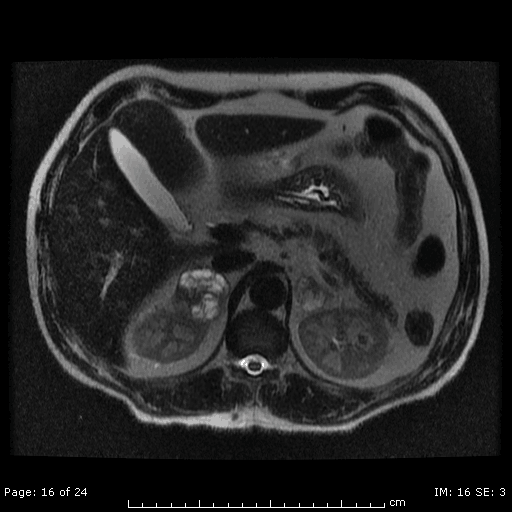
Pheochromocytoma is seen on CT as a soft tissue adrenal lesion, usually larger than 3 cm, with a central area of hemorrhagic necrosis. Exuberant and persistent enhancement is observed after IV contrast administration, typical of a hypervascular tumor.8 Calcifications, which are generally thin and peripheral, are present in 10% of cases.1
The tumor is characterized on MRI by low signal intensity on T1-weighted images and extremely high signal intensity, the “light bulb sign,” on T2-weighted images (Figure 7).2DR. CARLA RIBEIRO is a radiology resident at the Hospital de São Teotónio in Viseu, Portugal. DR. NUNO RIBEIRO is a radiologist at the same hospital. DR. JORGE OLIVEIRA is a radiologist at the Hospital Pedro Hispano in Matosinho, Portugal.
Assisting in the preparation of this manuscript were Dr. Carlos Ribeiro and Dr. Maria Grade from Hospital Pedro Hispano.
References
1. Kawashima A, Sandler CM, Fishman EK, et al. Spectrum of CT findings in nonmalignant disease of the adrenal gland. Radiographics 1998;18(2):393-412.
2. Elsayes KM, Mukundan G, Narra VR, et al. Adrenal masses: MR imaging features with pathologic correlation. Radiographics 2004;24(Suppl 1):S73-S86.
3. Francis IR, Gross MD, Shapiro B, et al. Integrated imaging of adrenal disease. Radiology 2002;184(1):1-13.
4. Caoili EM, Korobkin M, Francis IR, et al. Adrenal masses: characterization with combined unenhanced and delayed enhanced CT. Radiology 2002;222(3):629-633.
5. Chung JJ, Semelka RC, Martin DR. Adrenal adenomas: characteristic postgadolinium capillary blush on dynamic MR imaging. J Magn Reson Imaging 2001;13(2):242-248.
6. Krebs TL, Wagner BJ. MR imaging of the adrenal gland: radiologic-pathologic correlation. Radiographics 1998;18(6):1425-1440.
7. Mitchell IC, Nwariaku FE. Adrenal masses in the cancer patient: surveillance or excision. Oncologist 2007;12(2):168-174.
8. Paterson A. Adrenal pathology in childhood: a spectrum of disease. Eur Radiol 2002;12(10):2491-2508.
9. McLoughlin RF, Bilbey JH. Tumors of the adrenal gland: findings on CT and MR imaging. AJR 1994;163(6):1413-1418.
10. Guo YK, Yang ZG, Li Y, et al. Uncommon adrenal masses: CT and MRI features with histopathologic correlation. Eur J Radiol 2007;62(3):359-370.
11. Sahdev A, Reznek RH, Evanson J, et al. Imaging in Cushing’s syndrome. Arq Bras Endocrinol Metabol 2007;51(8):1319-1328.
12. Sohaib SA, Hanson JA, Newell-Price JD, et al. CT appearance of the adrenal glands in adrenocorticotrophic hormone-dependent Cushing’s syndrome. AJR 1999;172(4):997-1002. 13. Sohaib SA, Peppercorn PD, Allan C, et al. Primary hyperaldosteronism (Conn’s syndrome): MR imaging findings. Radiology 2000;214(2):527-531.
14. Lingam RK, Sohaib SA, Vlahos I, et al. CT of primary hyperaldosteronism (Conn’s syndrome): the value of measuring the adrenal gland. AJR 2003;181(3):843-849.
Can Abbreviated MRI Have an Impact in Rectal Cancer Staging?
April 4th 2025Abbreviated MRI demonstrated a 95.3 percent specificity for rectal cancer and provided strong agreement with the full MRI protocol for T staging and detection of extramural venous invasion, according to newly published research.
The Reading Room Podcast: Current Perspectives on the Updated Appropriate Use Criteria for Brain PET
March 18th 2025In a new podcast, Satoshi Minoshima, M.D., Ph.D., and James Williams, Ph.D., share their insights on the recently updated appropriate use criteria for amyloid PET and tau PET in patients with mild cognitive impairment.
GE HealthCare Debuts AI-Powered Cardiac CT Device at ACC Conference
April 1st 2025Featuring enhanced low-dose image quality with motion-free images, the Revolution Vibe CT system reportedly facilitates improved diagnostic clarity for patients with conditions ranging from in-stent restenosis to atrial fibrillation.